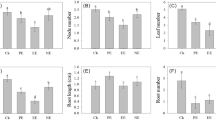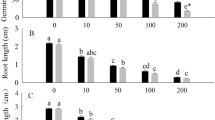Abstract
Although Plantago major and Plantago asiatica have similar life-history characteristics, P. major populations expand much more rapidly than P. asiatica in habitats where both species occur. One potential factor contributing to this disparity is the production of phytotoxic compounds. However, the phytotoxic characteristics of P. major and P. asiatica have not yet reported. Therefore, we conducted an investigation of possible phytotoxic compounds with allelopathic activity in both species. Aqueous methanol extracts of both plant species inhibited root and hypocotyl growth of garden cress (Lepidium sativum) in a concentration dependent manner. However, the inhibitory effect of P. major was greater than that of P. asiatica. The extracts were further purified by several chromatographic runs and two main phytotoxic compounds were isolated and identified through spectral analysis as (−)-3-hydroxy-β-ionone and blumenol A. (−)-3-Hydroxy-β-ionone and blumenol A inhibited the growth and germination of garden cress at concentrations greater than 1 and 30 μM, respectively. The level of (−)-3-hydroxy-β-ionone in P. major was 7.2-fold greater than that in P. asiatica, while the level of blumenol A was equal in both plant species. Although these Plantago species produce two main phytotoxic compounds with allelopathic activity, the higher level of (−)-3-hydroxy-β-ionone in P. major may result in it contributing the primary inhibitory effects of the extract of P. major. (−)-3-hydroxy-β-ionone may also serve to distinguish the invasive habit of two species and may be involved in the expansion in habitats of P. major.





Similar content being viewed by others
References
Bais HP, Weir TL, Perry LG, Gilroy S, Vivanco JM (2006) The role of root exudates in rhizosphere interactions with plants and other organisms. Annu Rev Plant Biol 57:233–266
Barnes JP, Putnam AR (1986) Evidence for allelopathy by residues and aqueous extracts of rye (Secale cereale). Weed Sci 34:384–390
Belz RG (2007) Allelopathy in crop/weed interactions—an update. Pest Manag Sci 63:308–326
Bonanomi G, Sicurezza MG, Caporaso S, Esposito A, Mazzoleni S (2006) Phytotoxicity dynamics of decaying plant materials. New Phytol 169:571–578
Callaway RM, Aschehoug ET (2000) Invasive plants versus their new and old neighbors: a mechanism for exotic invasion. Science 290:521–523
Callaway RM, Ridenour WM (2004) Novel weapons: invasive success and the evolution of increased competitive ability. Front Ecol Environ 2:419–426
Cappuccino N, Arnason JT (2006) Novel chemistry of invasive exotic plants. Biol Lett 2:189–193
Chengxu W, Mingxing Z, Xuhui C, Bo Q (2011) Review on allelopathy of exotic invasive plants. Procedia Eng 18:240–246
Chiang LC, Chiang W, Chang MY, Ng LT, Lin CC (2002) Antiviral activity of Plantago major extracts and related compounds in vitro. Antiviral Res 55:53–62
Conley TR, Peng HP, Mingh CS (1999) Mutations affecting induction of glycolytic and fermentative genes during germination and environmental stresses in Arabidopsis. Plant Physiol 119:599–608
DellaGreca M, Marino CD, Zarrelli A, D’Abrosca B (2004) Isolation and phytotoxicity of apocarotenoids from Chenopodium album. J Nat Prod 67:1492–1495
Dietz H, Winterhalter P (1996) Phytotoxic constituents from Bunias orientalis leaves. Phytochemistry 42:1005–1010
Drenovsky RE, Grewell BJ, D’Antonio CM, Funk JL, James JJ, Molinari N, Parker IM, Richards CL (2012) A functional trait perspective on plant invasion. Ann Bot 110:141–153
González AG, Guillermo JA, Ravelo AG, Jimenez IA, Gupta MP (1994) 4,5-Dihydroblumenol A, a new nor-isoprenoid from Perrottetia multiflora. J Nat Prod 57:400–402
Güldner A, Winterhalter P (1991) Structures of two new ionone glycosides from quince fruit (Cydonia oblonga Mill.). J Agric Food Chem 39:2142–2146
Hawthorn WR (1974) The biology of Canadian weeds. 4, Plantago major and P. rugelii. Can J Plant Sci 54:383–396
Hubbell SP, Wiemer DF, Adejare A (1983) An antifungal terpenoid defends a neotropical tree (Hymenaea) against attack by fungus-growing ants (Atta). Oecologia 60:321–327
Ikeda H, Okutomi K (1990) Effects of human trampling and multispecies competition on early-phase development of a tread community. Ecol Res 5:41–54
Ikeda H, Okutomi K (1992) Effects of species interactions on community organization along a trampling gradient. J Veg Sci 3:217–222
Ikeda H, Okutomi K (1995) Effects of trampling and competition on plant growth and shoot morphology of Plantago, Eragrostis and Eleusine species. Acta Bot Neerlandica 44:151–160
Kato-Noguchi H, Macías FA (2006) Possible mechanism of inhibition of 6-methoxy-benzoxazolin-2(3H)-one on germination of cress (Lepidium sativum L.). J Chem Ecol 32:1101–1109
Kato-Noguchi H, Kosemura S, Yamamura S, Hasegawa K (1993) A growth inhibitor, R-(−)-3-hydroxy-β-ionone, from light-grown shoots of a dwarf cultivar of Phaseolus vulgaris. Phytochemistry 33:553–555
Kobayashi T, Ikeda H, Hori Y (1999) Growth analysis and reproductive allocation of Japanese forbs and grasses in relation to organ toughness under trampling. Plant Biol 1:445–452
Lockwood JL, Simberloff D, McKinney ML, Von Holle B (2001) How many, and which, plants will invade natural areas. Biol Invasions 3:1–8
Mack RM (1996) Predicting the identity and fate of plant invaders: emergent and emerging approaches. Biol Conserv 78:107–121
Mathieu S, Terrier N, Procureur J, Bigey F, Gunata Z (2005) A carotenoid cleavage dioxygenase from Vitis vinifera L., functional characterization and expression during grape berry development in relation to C13-norisoprenoid accumulation. J Exp Bot 56:2721–2731
Matsuo K (1989) Ecological distribution and niche separation in two closely related ruderal plantain species, Plantago asiatica and P. major. J Phytogeogr Taxon 37:129–135
Meiners SJ, Kong CH, Ladwig LM, Pisula NL, Lang KA (2012) Developing an ecological context for allelopathy. Plant Ecol 213:1861–1867
Mohamed IK, Osama MA, Zahrat SE (2011) Biochemical studies on Plantago major L. and Cyamopsis tetragonoloba L. Int J Biodivers Conserv 3:83–91
Oracz K, Voegele A, Tarkowská D, Jacquemoud D, Turečková V, Urbanová T, Strnad M, Sliwinska E, G Leubner-Metzger (2012) Myrigalone A inhibits Lepidium sativum seed germination by interference with gibberellin metabolism and apoplastic superoxide production required for embryo extension growth and endosperm rupture. Plant Cell Physiol 53:81–95
Ritchie S, Gilroy S (1988) Gibberellins: regulationg gens and germination. New Physiol 140:363–383
Sagar GR, Harper JL (1964) Biological flora of the British Isles, Plantago major L., P. media L. and P. lanceolata L. J Ecol 52:189–221
Samuelsen AB (2000) The traditional uses, chemical constituents and biological activities of Plantago major L. A review. J Ethnopharmacol 71:1–21
Sunohara Y, Tsukagoshi S, Murata Y, Sukurai N, Nakamura K, Noma Y, Takahashi E (2000) Effect of trampling on shoot morphology and ethylene production in Plantago asiatica. J Weed Sci Technol 45:184–185
Thompson JD, McNeilly T, Gray AJ (1991) Population variation in Spartina anglica C.E. Hubbard. I. Evidence from a common garden experiment. New Phytol 117:115–128
Vartapetian BB, Jackson MB (1997) Plant adaptations to anaerobic stress. Ann Bot 79(Suppl):3–20
Watling JI, Hickman CR, Lee E, Wang K, Orrock JL (2011) Extracts of the invasive shrub Lonicera maackii increase mortality and alter behavior of amphibian larvae. Oecologia 165:153–159
Weston LA, Duke SO (2003) Weed and crop allelopathy. Crit Rev Plant Sci 22:367–389
Yuan Y, Wang B, Zhang S, Tang J, Tu C, Hu S, Yong JWH, Chen X (2013) Enhanced allelopathy and competitive ability of invasive plant Solidago canadensis in its introduced range. J Plant Ecol 6:253–263
Author information
Authors and Affiliations
Corresponding author
Additional information
Communicated by M. J. Reigosa.
Rights and permissions
About this article
Cite this article
Kato-Noguchi, H., Hamada, N. & Clements, D.R. Phytotoxicities of the invasive species Plantago major and non-invasive species Plantago asiatica . Acta Physiol Plant 37, 60 (2015). https://doi.org/10.1007/s11738-015-1794-y
Received:
Revised:
Accepted:
Published:
DOI: https://doi.org/10.1007/s11738-015-1794-y




